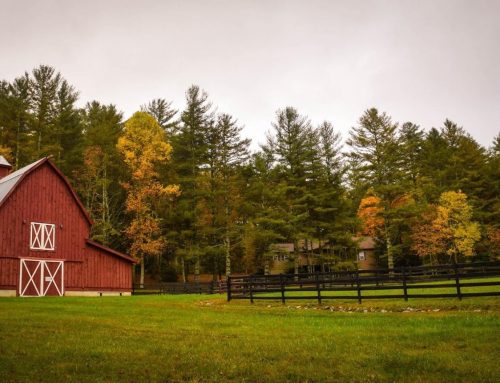Before purchasing a property, it’s important to know how it is zoned so you know if you can use the property for your intended purposes or not. Each community has its own set of zoning regulations and rules — make sure to know which zone your property falls under. Here are the most common zoning categories and what they mean.
How do you get an accurate zoning report for your property? With Millman National Land Services!
Related: What You Need To Know About Zoning Codes
Residential Zoning
Residential zoning includes single-family residences, suburban homesteads, and other designations like houses, apartments, co-ops, and condos.
Residential zoning laws cover issues like whether a mobile home is allowed to be placed on a property and how many structures can be built on specific properties.
These laws also typically limit which animals and how many of them are allowed at a residence. Domestic pets are not generally regulated, but farm animals are not usually allowed in residential areas, and the number of animals may be limited based on the property’s size.
Home-Based Businesses
Depending on local zoning laws, home-based businesses may not be allowed in residential neighborhoods, or they will have a strict ruleset for how you can operate your business. Some factors that play into the laws for in-home enterprises are:
- Whether or not there are additional employees.
- Signage.
- Parking and delivery methods.
- Noise issues.
- Operating hours.
- The type of business.
Home-based businesses in residential areas may have to work with limited business hours or have separate parking and entrances. These rules are typically more restrictive for condominiums than private residences.
Industrial Zoning
Industrial zoning laws are typically specific to different types of businesses. Environmental factors like noise concerns are used to determine the industrial zone that a company falls in.
Storage facilities and manufacturing plants have industrial zoning, while certain buildings, like airports, usually have their own designation.
Set-back requirements, building height, and the business’s floor area ratio all factor into industrial zoning.
Commercial Zoning
Commercial zoning has several different categories depending on how the business uses its property and the number of customers it brings in. Most real estate properties, other than single-family lots and homes, are commercial real estate. Some examples of commercial zoning are:
- Shopping centers and malls.
- Hotels and motels.
- Some types of warehouses.
- Office buildings.
- Nightclubs.
- Vacant land that has the potential to be used for these types of businesses.
Some things that affect commercial zoning are:
- Parking availability.
- Proximity to other businesses.
- The type of business.
- Distance between schools or churches.
Related: Why Do You Need a Commercial Zoning Report?
Agricultural Zoning
Agricultural zoning is typically found in communities that want to maintain the farm industry’s economic viability and usually limit the density of development and restrict the land’s non-farm usage.
In many agricultural zone districts, this density is maintained by having a minimum lot size for each residential unit and depends on the types of operations on the land.
Agricultural zoning laws help protect farming communities from being overrun by residential developments and is necessary for incentive, subsidy, and tax abatement programs.
Rural Zoning
Farms and ranches usually fall under the rural zoning district. These districts typically include residences that are zoned to allow horses, cattle, and other livestock.
Historic Zoning
Buildings and homes that are older than fifty years are considered historic zones. Regulations in these zones typically prevent changes from being made to the original structures other than restorations and repairs within the historic plan. Many of these buildings qualify for tax incentive programs.
Part of a national program designed to identify, evaluate, and protect these historic structures, the National Register of Historic Places lists the cultural resources deemed worthy of preservation.
Properties on this list include districts, sites, structures, buildings, and objects that are significant to U.S. history, engineering, culture, archeology, and architecture.
Owners of commercial, industrial, or residential buildings listed in the National Register can be eligible to receive a 20% investment tax credit for rehabilitation of certified historic structures.
Aesthetic Zoning
Aesthetic zoning is prevalent in many upscale communities, and it covers things like:
- Landscaping.
- Fences.
- Mailboxes.
- Color schemes.
- Decks.
- Satellite dishes.
- Solar Panels.
- Building materials.
These zoning codes often require an architectural review committee to approve the rules, and these zoning rules can sometimes impact wireless communication devices.
Land Use Zoning
In transportation and urban planning, different land use zones have their own sets of rules and regulations. Cities will usually have more than one type of land use zone; there are four main types of land use zoning.
Functional
Functional zoning is the most prevalent of the four, and these zones are defined according to how the property functions — whether as a commercial, residential, or industrial property.
Each of these zone types has a specific set of rules concerning which types of activities can be built on the property.
Form-Based
Form-based zoning defines zones by their physical characteristics — usually from the perspective of an urban identity, like a downtown area. It uses well-known zonal definitions, making it a more accessible form of zoning to relate to the general public.
Intensity
Intensity zoning defines the zones by how much intensity they are permitted to have — meaning the number of residential and commercial units based on the surface area. These zoning areas have high flexibility; developers can decide which types of structures to build on a property as long as they abide by the density constraints of the zone.
Incentive
Incentive zoning is typically offered as a revitalization plan for areas in a city, and it allows developers to build commercial, residential, or industrial projects in certain regions. Basic infrastructure and tax abatements are normally offered as incentives, along with the possibility of being granted lower density limit restrictions.
Why Is Zoning Important?
Zoning codes are essential for communities as it controls how the land can be used. Without zoning laws and restrictions, companies could open up any business right next to your home and disrupt your daily life.
While they may be a hassle to deal with sometimes, zoning is responsible for the structure that we have in our lives every single day.
Do you need a complete and thorough zoning report for your property? Get in touch with Millman National Land Services today!
Related: What Is the Purpose of Zoning?









